Part 1: How email is changing women’s lives
“What’s most memorable about my family email?
Just daily contacts and sharing cards, stories, etc. We
have exchanged everything from birthday information
to medical situations to pick-me-ups to drab daily things.”
— A 39-year-old woman describes
the role of email in her life
In the past six months, 9 million women have gone online for the first time. That is nearly 10% of adult women in the United States. Fully a fifth of all the women who have Internet access (21%) have gotten it in the past half year. That compares to the 15% of online men who are newcomers to the Internet. The fastest growing cohort is older women; 28% of female Internet users over age 50 have gained Internet access in the past six months.
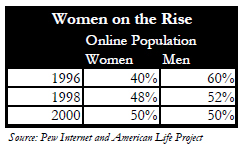
The new arrivals have a different profile from longtime Internet users, who more often are well-educated, well-paid men. Some 47% of the women who recently got access to the Internet have no education past high school; 54% of them are between the ages of 30 and 50; 53% of them are mothers of a child under 18; 54% of them have incomes of $50,000 or less.
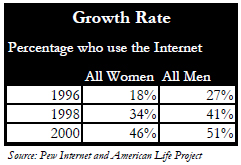
This newcomer status for a large proportion of women affects their relationship to the Internet. Men still go online more frequently than women do and spend more time doing things on the Internet. And men are still a majority of those online on an average day. Some 63% of men with online access log on to the Web or use email on an average day, while 57% of women with online access go online on an average day. Compared to women, men are more likely to seek news online, to do e-shopping, to seek financial information, to buy and sell stocks and bonds, to participate in online auctions, and to get information about politics and from government agency Web sites. Women are more likely than men, though, to seek health information and play online games. They are also a bit more likely than men to seek religious or spiritual information and hunt for material about new jobs.
The most conspicuous thing about online women is that they become attached to email early in their online life. That affinity has changed the way family members deal with each other and feel about their communications. Fully 65% of women who started online in the past year say they would miss email, compared to 55% of novice men who have the same feeling. Women’s affection for email has also reshaped the contours of families because women are somewhat more likely to use the Internet to rekindle relationships with family members who have been out of contact for a long time.
Why women love email
Women are more likely than men to feel that email has helped their relationships with family members and friends and women are more appreciative of the qualities of email. Fifty-seven percent of women who email family say they find email very useful for communicating with family members, while only 44% of men say that. Similar figures apply to women’s and men’s feelings about the utility of email for dealing with friends. Moreover, 56% of those women who email family say they would miss email a lot if they had to give it up, while only 43% of men say that. Among emailers, the largest group of those who say they would miss email a lot are women over 50, fully 60% of whom subscribe to that idea.
One of the major virtues of email to women is its efficiency. More often than men, women cite the time-saving aspect of sending email. Fully 65% of women who email family members say that because of email they can keep in touch with their family without having to spend as much time talking to them. Some 59% of men say that is true for them. About 27% of such women say the main reason they use email with a key friend is because it’s quicker than other forms of communication, while 22% of men say that. As one 46-year-old said in a message to the project: “I am now able to communicate with people in little odd stretches of time without using up a lot of my day.”
Email serves so many essential purposes for women that they are excited to get it. Over three-quarters of women emailers (78%) say they look forward to checking their email, compared to 62% of men who say that. Similarly, many women who maintain email relationships with relatives say email has bolstered their family ties. Forty-one percent of women who email family say email has improved relations in their families, while 34% of men say that. Some 43% of women who email family report that email has brought them closer to their families, compared to 37% of men who say that. And 27% of women who email family say they have learned more about their families since they began using email, while 23% of men feel that way.
Who women email and what women say in those emails
On a typical day, women are a bit more likely than men to send an email to their elders—that is, parents or grandparents. When it comes to the range of people on a person’s email list, women are more likely than men to include far-flung family members and friends on the list. For instance, 53% of women emailers say have reached out electronically to relatives in their extended families such as aunts, uncles, and cousins, while 43% of men say that. And 73% of women emailers say they have sent email to friends who live far away, compared to the 65% of men who say they have done that.
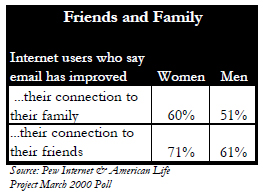
Women also are more inclined than men to use email for most types of electronic messages. Among those who exchange email with family, women are slightly more likely than men to:
- communicate something they are upset or worried about – 50% of women do this with relatives; only 34% of men do that
- pass along something they have heard about – 86% of women do this with relatives; 82% of men do it
- pass along something about their jobs or something they’ve been involved in – 74% of women do this with relatives; 70% of men do it
- pass along some news about family or friends – 85% of women do this with relatives; 81% of men do.
Part 2: How email improves Internet users’ social world
Email is extremely popular and its use has become part of the daily rhythms of tens of millions of Americans. It is integrated so deeply into users’ lives that it is changing the communications style in many families and among a wide range of friends. Some 48 million Americans send and read email each day—that is 87% of Internet users who access the Internet on any given day. In all, 84 million Americans report they have sent or read email at some point in their online life. Indeed, the tracking poll results suggest that Americans send more than 285 million emails on a typical day.
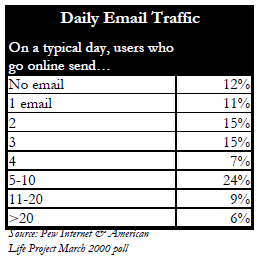
Large numbers of Americans have made a special effort to incorporate electronic communications into daily routines. Seven in ten email users say they look forward to checking their email. Four in ten say checking email is one of the first things they do after getting up in the morning. A similar number report it is one of the last things they do before going to bed. If they were asked to give up email, three-quarters (77%) said they would miss it. Half of email users (49%) said they would miss it a lot. More women than men report they would miss email.
Email: The isolation antidote
This survey provides clear evidence that email and the Web have enhanced users’ relationships with their family and friends – results that challenge the notion that the Internet contributes to isolation. Significant majorities of online Americans say their use of email has increased the amount of contact they have with key family members and friends. Fifty-nine percent of those who exchange email with a family member say they are in contact with that relative more often thanks to email. Only 2% say they are in contact less often with this family member since they struck up their e-correspondence. Email users say virtually the same thing about the frequency of their contact with close friends via e-letters. Sixty percent of those who email friends say they communicate more often with a key friend now that they use email and 2% say they do so less often.
As a group, Internet users are more likely than nonusers to have a robust social world. The use of email seems to encourage deeper social connectedness. The longer users have been online, the more likely it is that they feel that email has improved their ties to their families and friends. Forty percent of Internet veterans—those who have been online for at least three years—say there has been a lot of improvement in their connections with family and friends because of email, compared with just over a quarter of Internet newcomers (those online for six months or less) who report that.
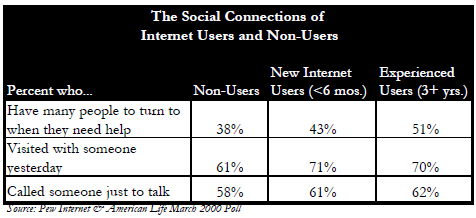
Internet users are also more active socially than nonusers, and users do not report any measurable falloff in their ties to their family and friends because of their involvement with the Internet. Nearly three-quarters of Internet users (72%) say they visited family or friends “yesterday,” while 61% of nonusers report they had visited someone. About 61% of Internet users phoned a relative or friend just to talk “yesterday,” and 58% of nonusers said that.
More than those who have no Internet access, Internet users say they have a significant network of helpful relatives and friends. Some 48% of Internet users say they can turn to many people for support in a time of need, while just 38% of nonusers report they have a large social network. Furthermore, only 8% of Internet users indicate they are socially isolated – that is, they say they have no one or hardly anyone they can turn to for support. In contrast, 18% of nonusers say they have no one or hardly anyone to turn to.
The Internet effect
Online Americans say Internet tools enhance important relationships. Large majorities of those who email family and friends say email is useful for these communications (88% and 90% respectively). Half of those who email friends (51%) say the electronic communication has brought them closer, while among those who email family 40% say it has brought them closer to their families. Only 5% of family emailers say electronic messages have added to the stress in their families and a scant 4% of friend emailers say email use has added strain to their friendships.
Tellingly, the heaviest users of the Internet are the ones who more often say they reap benefits from email. Compared to casual Internet users, fervent Internet citizens— those who have the most Internet experience and who log on most frequently— are more likely to say: email has improved their connection to members of their family and friends; email has improved relationships in their families; email has brought them closer to their families; they have learned a lot about their families thanks to email; and that they have started communicating regularly with a family member whom they had not contacted much before.
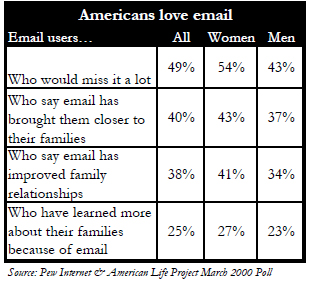
Those who use the Internet the most do not seem to suffer social losses even when they spend a lot of time online. Longtime and heavy Internet users are just as likely to have visited or phoned a friend or family member “yesterday” as those who do not use the Internet or those who are less-than-avid Internet users. Some 71% of those who were online two or more hours “yesterday” say they visited with family or friends, compared to 61% of nonusers and 70% of those online less than an hour. Some 61% of those who logged onto the Internet once or more “yesterday” also phoned a friend or relative just to chat, while 58% of nonusers said they did the same thing.
In addition, the amount of time spent online by the heaviest users does not seem to affect their capacity to have a large social network. Forty-eight percent of those who were online for more than two hours “yesterday” say they have a large social network; and 49%
The Web expands horizons and helps users cope
Another finding that cuts against the argument that the Internet encourages seclusion is that Internet users say they feel more plugged into the world because of the information they find online. More than three-quarters of those with Internet access (78%) say the Internet has improved their ability to learn about new things. Experienced users expressed even more satisfaction with how the Internet has helped them expand their horizons. Fully 83% of them report that the Internet has improved their ability to learn new things. Some 62% of Internet newcomers reported feeling the same way.
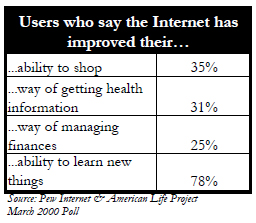
Moreover, significant numbers of Americans say the Internet has given them more control over important aspects of their lives. Some 35% of online Americans say the Internet has improved their ability to shop; 31% say the Internet has improved the way they get information about health care; 25% say Internet tools have improved the way they can manage their personal finances. The longer someone has been on the Internet, the more likely she is to say the Internet has improved her control over these areas of her life.
Shifting family communication
Some family communications now revolve more around email than other forms of contact. Asked about the person in their family whom they email most often, 22% of family emailers report they send this family member an email every day, while 16% say they phone this significant family member every day, and only 8% get together with this family member every day.
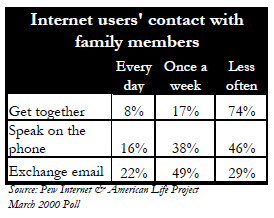
A sizeable majority of those who email relatives say it increasing the level of communication between family members. Six in ten family emailers say they communicate more often now with their primary family contact. And the same proportion of those who email friends say the same thing about increased communication. It appears that a big part of the jump in volume comes from the exchange of informal and fun e-communications. Asked to describe the kinds of messages they send to a family intimate, respondents said they use it for all kinds of info-nuggets, especially those meant to pass along interesting, entertaining, newsy personal information. “We use emails mostly for passing information,” said one survey respondent in a message to the project. “But it is great to hear about each other’s accomplishments and keep in close touch. Probably the most memorable exchanges we’ve had involve helping cousins far away with school projects.”
However, when it comes to more sensitive matters, people use email more discriminatingly. A fifth of family emailers (19%) say they think email is too impersonal a method to use when they are sharing information with their families. Even for those who are comfortable sending email to family members, there is a kind of intimacy/appropriateness scale they employ when they think about writing to relatives. In contrast to the more than 80% of family emailers who send informational notes to relatives, only 48% say they have sought advice from family members with online communications and just 42% say they have written email about something that upsets or worries them. At the same time, it is worth noting that at least four in ten of those who email family use this form of communication when they are dealing with sensitive matters.
One of the appealing attributes of email to a surprisingly large cohort of Americans is that they feel they can be more honest online with loved ones and friends than they can be in conversation. Almost a third of family emailers (31%) report that it is easier to say frank or unpleasant things in electronic missives than it is in conversation. Asked if they thought this was a good or bad thing for their families, two-thirds of these emailers said it was a good thing.
New lines of communication
There is other evidence that email is rearranging communication patterns within families. Not only does the volume of communication grow inside families where email is used, but also it might be the case that email is used in those families at times as substitutes for conversations. Some 62% of those who email relatives say that because of email they can stay in touch with family without having to spend as much time talking to family members. Several groups of email users particularly subscribe to that idea. The first group is women. Some 65% of women who send email to relatives say email allows them to keep in touch with their family without having to spend so much time talking to them. By comparison, 59% of men say that. Frequent and heavy Internet users also say this. Two-thirds (66%) of family emailers who log on daily say that with email they don’t have to talk as much to relatives. Roughly the same share (67%) of those who say they logged on “yesterday” report the same thing.
Email your brother rather than chat him up
Another batch of evidence that email changes family communication relates to sibling exchanges. Many siblings send electronic messages to each other more often than they place phone calls. Some 69% of those with email relationships with a brother or sister send an email to that sibling at least once a week. Only 44% of them phone that sibling at least once a week. It is possible that email represents additional communication that might not otherwise occur. As one 41-year-old woman commented: “Little funny things that my nieces and nephews do that wouldn’t be worth a long distance phone call I get to hear about through e-mail.”
By way of comparison, there is much less difference in the frequency of phone calls and emails exchanged between those in different family generations. Seventy-six percent of those with email relationships with their children send an email once a week or more often; and 78% of them phone that child once a week or more often. The notable thing about those exchanges is that for most intergenerational family emailers, electronic messages are being sent now as frequently as phone calls are placed.
Getting blunt with mom, dad, and sibs
Many of those who email family, with some exceptions, feel it is easier to say frank or unpleasant things in email. Some 34% of those who email brothers or sisters and 33% of those who email their parents say it is easier for family members to say frank or unpleasant things in email than in conversation. But only 19% of parents who email their children feel that way. Still, there seems to be a payoff to these candid exchanges—emailers who hold this view say that email has improved relationships in their families.
Yet, there is a sizeable group of sons and daughters who exhibit an opposite tendency. They believe that email is too impersonal a communication form to use with their parents. Some 23% of sons and daughters who email their parents believe that, compared to just 13% of parents who email a son or daughter.
Parents who email their children are less likely to send burdensome messages. For instance, they are less likely than other family emailers to say they seek advice in emails with the children or to convey blunt messages. Some 42% of those who send email to their children say their emails involve the seeking of advice. In contrast, 55% of those who email their siblings tout that attribute of email.
Celebrating families and restoring communication
Many Americans use the Web to post information about their families. Some 16% of Americans say they or another family member has a family Web page with pictures or information about the clan. And 29% say they or a family member had done genealogical exploration or other research related to their family’s history. Wealthier, better-educated, and more experienced Internet users are more likely to use the Web to spread family news or to construct a family tree. Some 26% of Internet users with family incomes over $75,000 say they or another family member has a Web page, as do 22% of college graduates.
Equally as important, the online public’s interest in family background extends to direct communications among family members. A quarter of those who email relatives say they have learned more about their family since they began using email with family members. Fully 39% of those who email friends say they have learned more about their friends thanks to e-communications.
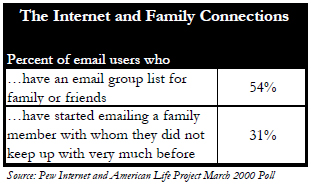
In a surprisingly large number of cases, email and the Web are being used to restore users’ lost connections or broken ties with family and friends. A third of emailers (31%) said they had used email to resume communicating with a family member they had not often contacted in the past. In many cases, that restored relationship was with someone in the users’ generation, such as a sister, brother, or cousin. And 28% of those online said they have used email or the Web to look for or locate an old friend or family member with whom they had lost contact. Internet veterans are more inclined to do that – 34% of those online for more than a year have used email to hunt or find a relative or friend, while 16% of newcomers with six months or less online say they have done that.
Problems with email
Electronic communication is not an unqualified benefit for everyone. For about a third of those who use email, unwanted email is a problem. Thirty-seven percent of Internet users report that getting a lot of spam (the electronic equivalent of junk mail) or unwanted emails is a problem, compared to the 63% of email users who say it isn’t a problem. Those with the most experience on the Internet are more likely to complain about too many unwanted emails. Some 41% of those who have been online a year or longer complain about spam, in contrast to 20% of those who have first started going online in the last six months.
For those who feel inundated by unwanted email, 70% say the offending messages are sales solicitations, 17% say the emails are from other people they don’t care to hear from as much, and 7% say the unwanted emails come from list-servs, that is, a group of email users who post their thoughts to all the other members of the group. Some 41% of those who get lots of unwanted messages say the volume of undesired messages is such a hassle that they find it hard to get to the emails that matter most to them. Finally, 29% of email users grouse that dealing with e-messages takes up a lot of their time.
Part 3: Daily life on the Web
One of the most striking pieces of evidence of how the Web has become woven into people’s everyday lives is the amount of time people spend on the Internet and the frequency with which they go online. The timescape looks like this: Every day 60% of those who have Internet access, some 55 million Americans, go online. Of the people who go online on an average day, 56% logged on exclusively from home, 21% logged on exclusively from work, and 20% logged on from home and work. Half of the Internet users (56%) who go online on any given day spend an hour or more online during all their online sessions; 36% said they had spent a half hour to an hour; and about a quarter said they had spent less than a half hour.
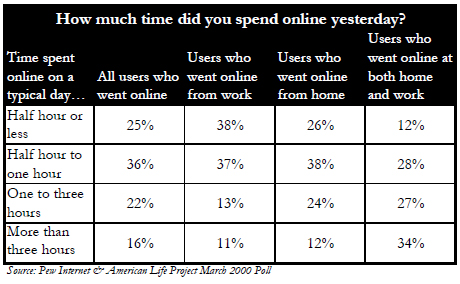
People who are new to the Internet spend less time online than veterans. Some 35% of people who have come online in the past 6 months logged on for less than a half hour per day, compared with 20% of people who have been on the Internet for more than a year who spent a relatively small amount of time online. Some 61% of people who have been Internet users for more than a year spend an hour or more online. About 46% who have come online in the past six months spend an hour or more per day online.
More than half of those who have Internet access at home (52%) go online once a day or more often. Two-thirds of those who access the Internet from work go online once a day or more often.
Internet veterans: A breed apart
A core of veteran users—the 28% of Internet aficionados who have been online for more than three years—are increasingly integrating the Internet into their routines. These 26 million Americans are one third of those who go online on any given day. More than half of this group (54%) have Internet access from home and work and half (51%) log on several times a day. On any given day, a veteran is substantially more likely to spend two or more hours on line than a nonveteran is.
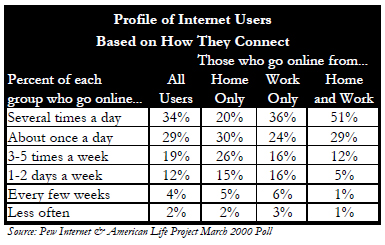
The veterans’ cohort reflects some of the demographic characteristics of Internet users at the dawn of the Web in the mid-1990s. This group is composed of more males than females, more whites than minorities, more college graduates than those with less education, and more Americans making over $75,000 than those earning lower incomes.
Their involvement with the Internet is tied to two big trends: First, the Internet has become an important job-related tool for veteran users. Nearly two-thirds of them (64%) report going online to conduct research for their jobs. That contrasts with the 29% of newcomers (those who have been online for less than six months) who have done job-related research online. A similarly high proportion of the Internet longtimers (62%) have done research for school or training online, compared to 42% of Internet newcomers who have done this. For school or job-training research, the fairly high share of new users who do such research on the Internet suggests that the Internet is widely viewed as an indispensable tool to gain the requisite skills for the “knowledge economy.”
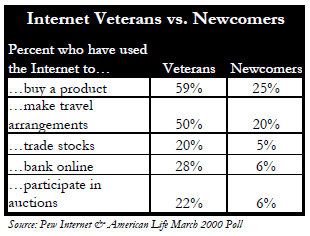
The second trend is that veterans find that the Internet helps them manage important aspects of their lives. Compared to those just starting to use the Internet, high proportions of veterans have bought products, purchased travel services, bought and sold stocks, banked online, and participated in online auctions. Overall, 38% of veteran users say the Internet has helped improve management of their personal finances, as opposed to 11% of new users. And 43% of veteran users report that the Internet has improved their ability to shop, versus 21% of new users.
Those offline
Despite the continuing growth of the Internet population, about half of Americans do not go online, and as a group they are somewhat different from Internet users. In general, these nonusers are older, more likely to be female, less wealthy, less likely to be employed and less educated than Internet users. African-Americans in particular lag in their representation among those online.
Almost half (49%) of non-Internet users are over the age of 50. The difference in educational levels is also striking; 70% of non-Internet users have a high school education or less, and only 12% are college graduates. Not surprisingly, lower income people are less likely to go online; 37% of non-users have family incomes under $30,000.
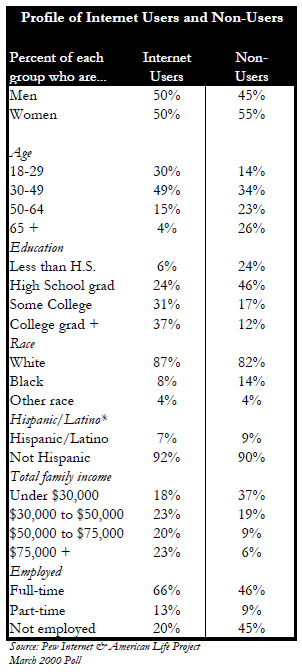
With respect to race, even the rapid increase of African-American Internet users has not prevented that group from having a disproportionately high number of non-Internet users. About 35% of African-Americans are online, compared to 50% of whites and 46% of Hispanics. The survey does show that African-Americans are coming online at a faster pace than whites. Of all African-American Internet users, 30% have come online within the last six months compared with 16% of the white Internet population. Put differently, fully 14% of those who started going online in the last six months are African-American.
Some 14% of non-Internet users are African-American, a substantial difference from the 8% of all Internet users who are African-American. In contrast, the increase in Internet use by Hispanics has brought their proportion of the online population in synch with their proportion of the overall U.S. population.
Part 4: Who does what online
There are three basic patterns among Web activities. The first involves online behaviors that women exhibit more than men; the second involves online behaviors that men exhibit more than women; and the third is a group of activities where there are no major gender differences, yet generational differences are quite striking.
In many traditional ways, women’s and men’s behavior on the Web mirrors their behavior in consuming other forms of media, in performing everyday chores, and in enjoying leisure time. Just as women and men tend to watch different television shows, read different sections of the newspaper, and purchase different types of magazines and books, so they also gravitate to the online activities that resemble the media products they like.
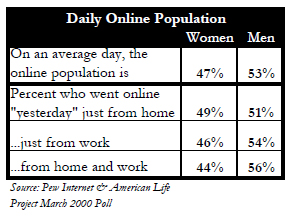
One anomalous online trait evident in this survey is that men are more inclined than women to buy things online and do research related to those purchases. It is possible that this stems from the reality that more men than women have lots of experience on the Web. Recall that 21% of online women got their first access to the Internet in the last six months, compared to 15% of men. At the other end of the experience scale, 33% of online men have had Internet access for three years or more, while just 24% of women have that much experience. Thus, it is possible that this difference in behavior between men and women will vanish as women become increasingly comfortable navigating the Web.
However, there is a third pattern of behavior that is not gender driven but is oriented around Web-based activities that relate to school work, leisure-time communication, popular culture, and convenience activities. In these areas, the division in the ranks of Internet users revolves around the age of users. Younger adults of both sexes who have likely grown up around the Internet are equally at ease doing research for school and job training. They also are equally inclined to enjoy new forms of communication that have been introduced on the Internet such as chat rooms and instant messages. Similarly, they enjoy wiling away time browsing the Web. There is not any gender-based difference in the behavior of younger respondents when they use the Web to enjoy popular culture. Young people of both sexes are equally likely to listen to and download music from the Web and seek information about movies and books. And young adults of both sexes plan and make travel arrangements and do banking online with roughly the same frequency.
Women’s favorite Web activities
Looking for health or medical information. Six in ten women (61%) with online access have gotten medical information, while 47% of men have done this. On a typical day, 9% of online women get health information on the Web and just 4% of men do that. The difference in behavior between the sexes is most evident in generational terms; older online women (those over 50) are the most likely to have sought health information. Some 65% of women that age have sought health information online. In contrast, young men (those under 30) are less likely to have sought such material. Only 40% of young men have accessed health information online. And just 48% of older men get medical material from the Web.
Apart from gender, the age of an Internet user is an important variable when it comes to seeking health information on the Web. Fully 58% of users between the ages of 50 and 64 have sought health information online. In contrast, 49% of the Internet population between ages 18 and 29 have checked out medical information on the Web. Moreover, a person’s level of experience with the Internet plays a noticeable role. Some 43% of those who have just gotten online in the last six months have been to a health-related site, while more than 58% of those who have been online more than a year have sought health-related material online. There is a 2-1 margin on a daily basis between Internet veterans and newbies looking for health information. Eight percent of those online more than a year check out health material on the Web on an average day, while just 4% of newcomers do so.
Checking out job information. There is a modest gender gap on this Internet activity. More than four in ten of the women (41%) who have Internet access say they have sought job-related information, while 35% of men have done that. The sex-based differences hold up for every age cohort. Fifty-six percent of online women between ages 18 and 29 have sought job information and that compares to 46% of men.
But as much as there is a gender-based story on this activity, there is an even greater difference attributable to the age of Internet users. Fully 56% of online women ages 18-29 who have sought job information compare to the small proportion of women over 50 who have done that – just 17% of online women over 50 have sought job information. This difference is likely due to the greater amount of job switching that young people do relative to older people. On a typical Internet day, 7% of Internet users between ages 25 and 29 look for material related to a new job, while less than 3% of those over 50 with Internet access do job-hunting online.
Playing a game online. One of the unexpected findings in the tracking poll was that women are slightly more likely than men to play games online. Some 37% of online women say they have played a game, while 32% of men say that. On a typical day, 6% of online women and 5% of online men play a game on the Web. The differences become more evident as the age of the Internet user increases. Young women and men with Internet access play games on the Web at about the same frequency. Fully half of those ages 18 to 24 have played games online. Yet the gender gap grows with aging. Some 35% of online women between the ages of 30 and 49 have played games on the Web and 7% of them do so on an average day, while just 28% of men that age have ever played games and only 4% of them do it on a typical day. Similarly, 31% of women 50 and over have played an online game, while just 21% of men that age have done so.
Unlike the pattern for many Internet activities, the pattern here is that those with less education are the ones who, relatively speaking, participate more in online game playing. Some 46% of those with a high school education or less have played online games. In contrast, 24% of those who have completed college have played an online game. And game playing is something Internet novices do with just the same frequency as Internet veterans.
Hunting for religious or spiritual information. Some 23% of online women have ever done this and 3% of them seek spiritual material on a typical day. By way of contrast, 19% of online men have ever sought religious information online and 2% do it on an average day. Baby boomers make up the biggest bloc of spiritual seekers. Of Internet users between the ages of 40 and 49, 27% have ever sought spiritual information. And the gender gap grows a bit during middle age. Fully 27% of women ages 30-49 have gotten religious material on the Web, while 22% of men that age have performed that activity.
Beyond gender issues, race plays a role in this activity. African-Americans with Internet access are substantially more likely than other groups to have checked out religious or spiritual Web sites. A third of Internet-using African-Americans (33%) have sought religious information on the Web, while just 20% of online whites and 20% of online Hispanics have done so.
Men’s favorite Web activities
Getting news. Two-thirds of online men (66%) have gotten news on the Internet at some point, and only about half of female Internet users (53%) have ever gotten news online. On an average day, 29% of men with Internet access get news, and there is an especially heavy showing of men in the 30-49 age range. Young women, on the other hand, are less likely to seek news online; only 12% of women under age 30 get news off the Web on an average day.
Men and women also differ in the way they approach news online. More than online women, men log on to learn news. On a typical day, 42% of men who got news online checked the Web to learn what was happening in the world; only 35% of women who sought news online logged on to learn the news. However, more women than men go online to follow up on things they have heard about elsewhere; 18% of the women who get news online are following up on things they heard someplace else, while just 12% of online men access news information on the Web for that reason.
Regardless of gender, the wealthier and more educated Internet users are more likely to go online for news. Sixty-four percent of college graduates have gone online to get news compared with 54% of high school graduates. The wealth effect is a bit more pronounced; 69% of users whose family incomes exceed $75,000 go online to check news versus 55% of users with incomes below $30,000.
Getting financial information such as stock quotes. The gender gap is stark here. Some 52% of online men have done this, yet just 35% of women have done it. On a typical day, the difference widens to a greater than 2-1 margin: 22% of online men seek financial information daily and just 9% of online women do that. Notably, one quarter of online men between the ages of 30 and 49 get financial information on a typical day.
Not surprisingly, the act of getting financial information from the Internet is highly correlated with income and education. Fully 63% of Internet users with family incomes above $75,000 have gone online to look for financial information, and 26% of these high-income people do this on an average day on the Internet. Only about one-quarter (26%) of Internet users with incomes below $30,000 have ever gone online to get financial information, and 9% do this on a daily basis. And 56% of college graduates have gone online to look for financial information compared with only 36% of those with high school educations.
Selling and buying stocks and bonds. Men are also more likely to complete certain financial transactions online; 16% of online men versus 9% of online women have bought or sold stocks and bonds online. On a daily basis 4% of men and 1% of women do this.
More stark are the differences between those with high income and those with less income and those with Internet experience and newbies. Eighteen percent of college graduates have bought or sold stocks online. Twenty-five percent of Internet users with incomes above $75,000 count themselves as online traders, but the percentages drop precipitously as income levels go down. Users with three or more years of online experience are clearly comfortable with the virtual market concept—20% have traded stocks online. Users who just got online in the last six months are less likely to take that leap—only 5% have traded online.
Looking for information about a product or service. Overall, 80 percent of men have done this, compared to 67 percent of women. On a typical day, 18 percent of online men seek product information and 10 percent of women do. Young men make the biggest difference: Four-fifths of online men under the age of 30 have sought product data and fully a fifth of them (21 percent) do it on an average day. As might be expected, highly-educated Internet users are somewhat more likely to go online in search of product information.
While most people shop at home, workday browsing is also popular. Seventy-two percent of home-only Internet users say they have researched product information and 58% of work-only users reported browsing on the job.
When it comes to buying products, though, the gender gap virtually disappears. Forty-nine percent of online men and 46 percent of online women say they have bought something like books, music, toys, or clothing online and four percent of both men and women do this on a typical day on the Internet. At-home shoppers dominate and are more likely to follow through with a purchase than work-only Internet users. Forty-six percent of home-only users have bought a product or service online, with 4% making a purchase on a typical day. One-quarter of people who access the Internet from work (25%) have made a purchase at some time in the past and 2% do this on a typical day.
The biggest cohort of online purchasers are people in their thirties and forties. Fifty-two percent of online buyers are 30-49 years old and 29% are 18 to 29 years old. In addition, high-income, well-educated and more-experienced Internet users are more likely to buy products and services online. Only 15% of online buyers have an annual family income of less than $30,000. Compare this to the 30% of online buyers who have an annual family income over $75,000—the highest purchase rate of all income groups. Some 62% of those with this kind of income have bought something online. Similarly, college graduates make up 44% of the online buying public.
Users who got Internet access within the last six months are also less inclined to type in their credit card number—25% have bought something—than users who have been online for over three years, 59% of whom have purchased something on the Internet.
Participating in an online auction. Almost a fifth of male Internet users (19%) have participated in an online auction, compared to 11% of female Internet users. Young men are more avid auction participants. Twenty-three percent of men ages 18 to 29 with online access have at least bid in an online auction and 5% of that age group do so on a typical day; while only 9% of online women that age have ever participated in auctions and less than 1% of women in that age bracket are participating in auction sites on a typical day.
Looking for information about a hobby or interest. The gender gap is nine points here: 80% of men with access to the Internet have done this, while 71% of women have done it. Younger Americans are more likely to get information about a hobby than their elders. The largest cohort of those who have ever sought hobby information are men between ages 18 and 29. Fully 88% of them have ever done that and 28% of online men in the youngest age bracket (18-29) do that on an average day on the Internet. In contrast, just 17% of young women online and 12% of women over age 50 seek hobby information on a typical Internet day.
Seeking information about politics and the campaign. Thirty-nine percent of the men with Internet access have done this, compared to 30% of women. On a daily basis, the gap widens to 2-1; 13% of online men seek political information on a typical day and only 6% of women do this. Men in the age range of 30-49 are the heaviest consumers of political information. Fifteen percent of them get political news online on an average day, compared to just 6% of women that age. Also, 41% of college educated Web users consume online political information, as opposed to 31% of users who have completed high school.
Hunting down information from a government Web site. This month’s survey was done in the height of tax season and it was striking to find that 7% of all Internet users went to a government Web site (federal, state, or local) on a typical day. At least in March, on a typical day, that put the number of users seeking information from government Web sites on par with the number of Internet users seeking travel information and the number seeking health information. Government Web site visitors outnumbered those participating in chat rooms or online auctions.
Some 52% of online men have ever sought information from a Web site run by any kind of government agency – 11 points more than the 41% of online women who have gotten information on government Web sites. On a typical March day, 9% of men and 6% of women were checking out government Web sites. Men over the age of 30 were the heaviest consumers of this type of information – more than 57% of them have ever accessed government Web sites and on an average day 11% of them do that. In contrast, about 5% of women over 30 click to a government Web site on a standard day.
A person’s education level is also a strong determinant here. Fully 61% of those with college educations have sought information from government Web sites and 10% college graduates go to a government Web site on a typical day. On the other hand, 37% of those with high school educations have consulted government Web sites and just 4% of them do it on an average day.
Checking sports scores and information. Not surprisingly, men dominate this activity by a 2-1 margin: 46% of online men have ever gotten sports information, while just 23% of women have done that. On normal days, the gap widens to 3-1; 12% of online men get sports scores and 4% of women do that on an average day. Not surprisingly, young men are more interested in sports information – 16% of online men seek sports material on a typical day, while only 3% of young women do so.
Gender equivalence, a generational story
- Neo-leisure
Sending instant messages. There are no discernable differences between online men and online women as broad groups. But instant messaging is definitely a young person’s activity. Fully 59% of those ages 18-24 and 55% of those 25-29 have done this. Seventeen percent of those online from ages 18 to 24 send instant messages on a typical day, compared to just 11% of those over 50 who do so daily.
Taking part in chat rooms. Twenty-eight percent of men with access to the Internet and 27% of women say they have done this. On a typical day, 5% of online men and 4% of online women participate in online discussions. Along generational lines, though, the differences are stark. Fully 53% of Internet users ages 18-24 have participated in chat rooms, and 8% of them do it on an average day. In contrast, only 14% of those 50 and over have ever done online chat and less than 3% of that older group do it on a typical day.
Browsing the Web for fun. The most telling story here is that 63% of Internet users have gone online for no particular reason—just for fun—and about a fifth of Internet users (21%) do it on a typical day. The largest browser cohort is young online men, 27% of whom browse for fun or to pass the time each day. Some 23% of online women under age 29 browse for fun on a standard day, but only 14% of online women who are 50 or older do this daily.
- Digital popular culture
Listening to or downloading music. A bit more than a third of online men (37%) and online women (34%) have ever done this, though on a typical day twice as many online men (6%) as online women (3%) listen to music or download it. However, 58% of Internet users between 18 and 24 have listened to music, while only 20% of those over 50 have done so. The differential spreads to more than 3-1 on a daily basis as 10% of those 18-24 listen to or download music each day, compared to less than 3% of those over 50.
Seeking information about movies, books, or other leisure activities. Sixty-one percent of online men and 64% of online women have used the Internet to find information about books, movies, music, or other leisure activities. On a typical day, 8% of online users are searching for this type of information. An interest in leisure information cuts across income and education lines. But young people are more than twice as likely to have ever gone online for this than senior citizens. Seventy-one percent of 18 to 29-year-old users have researched a book or movie, compared to 35% of users aged 65 or older.
- Convenience activities
Getting information about travel and purchasing travel services. Equal numbers of online men (64%) and online women (65%) have used the Web to check airline ticket prices or hotel rates. On an average day, 7% of Internet users get travel information. Users between ages 25 and 29 are the most likely to have gotten travel information—72% have done this.
When it comes to purchasing an airline ticket or making a hotel reservation, 37% of online men and 35% of online women have completed a travel-related transaction. More young online women have done this (40%) than young men (31%). Internet users with higher incomes, more education, and more online experience tend to use online travel services. Some 54% of Web users with family incomes over $75,000 a year have sought travel information, while only a third of those users with incomes between $30,000 and $50,000 have done so. Forty-six percent of college graduates have sought travel information, while only 26% of high school graduates have done so. Fully half of users (50%) with three or more years of online experience have made a travel reservation online. People who just got online in the last six months are much less likely to buy a ticket or rent a car online—only 20% have used an online travel service.
Banking online. Men and women are equally comfortable with virtual finances: 18% of men and 17% of women bank online. Education, income, and experience make the greatest differences. Twenty-three percent of college graduates have banked online, compared to 14% of high school graduates. Some 27% percent of Internet users in the highest income bracket have banked online, compared to 17% in both the $50,000-75,000 and $30,000-50,000 ranges. Users with more than three years of online experience are much more likely to take care of their finances online. Twenty-eight percent of Internet veterans bank online, compared to 10% of users who got online in the past year.
- Knowledge work
Doing research for school or training. This is a generation-driven activity. Far and away the largest group doing this online is the young. Eight in ten of those with Internet access between 18 and 24 have done research for school or training, compared to just 33% of those over 50. On most days, fully 19% of men between ages 18-29 do training or school-related research.
Doing research for work. There is a slight gender gap here – a five-point spread that puts online men ahead. But the more important point is that those ages 25-29 most often do work-related research on the Web. A fifth of those in that online age bracket do research for work on a typical day. There is a wide education gap with this activity; 65% of Internet users who are college graduates have gone online to do work-related research versus 35% of high school graduates.




